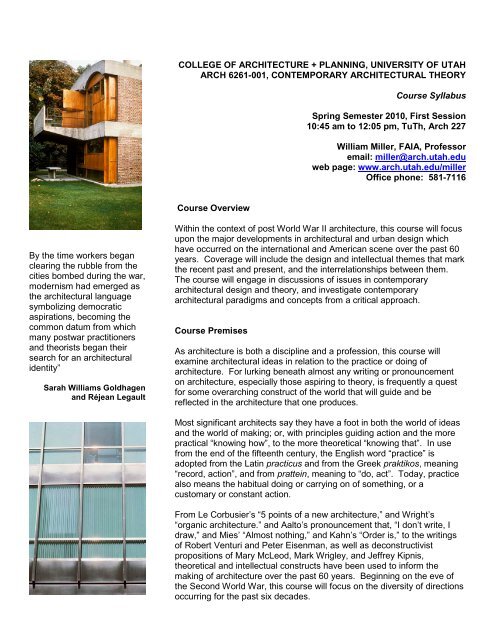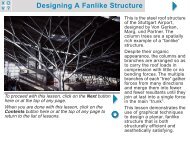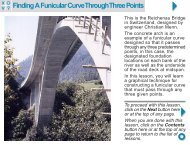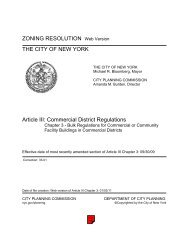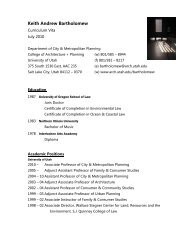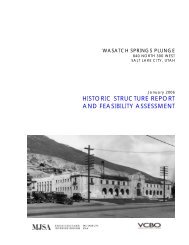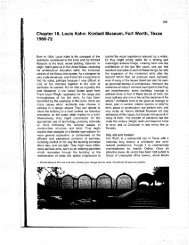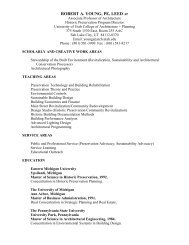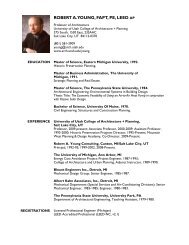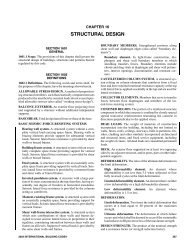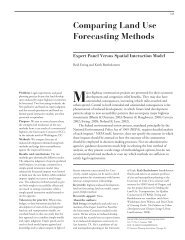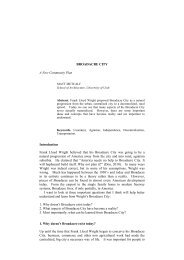Syllabus - University of Utah Graduate School of Architecture
Syllabus - University of Utah Graduate School of Architecture
Syllabus - University of Utah Graduate School of Architecture
You also want an ePaper? Increase the reach of your titles
YUMPU automatically turns print PDFs into web optimized ePapers that Google loves.
By the time workers began<br />
clearing the rubble from the<br />
cities bombed during the war,<br />
modernism had emerged as<br />
the architectural language<br />
symbolizing democratic<br />
aspirations, becoming the<br />
common datum from which<br />
many postwar practitioners<br />
and theorists began their<br />
search for an architectural<br />
identity”<br />
Sarah Williams Goldhagen<br />
and Réjean Legault<br />
COLLEGE OF ARCHITECTURE + PLANNING, UNIVERSITY OF UTAH<br />
ARCH 6261-001, CONTEMPORARY ARCHITECTURAL THEORY<br />
Course Overview<br />
Course <strong>Syllabus</strong><br />
Spring Semester 2010, First Session<br />
10:45 am to 12:05 pm, TuTh, Arch 227<br />
William Miller, FAIA, Pr<strong>of</strong>essor<br />
email: miller@arch.utah.edu<br />
web page: www.arch.utah.edu/miller<br />
Office phone: 581-7116<br />
Within the context <strong>of</strong> post World War II architecture, this course will focus<br />
upon the major developments in architectural and urban design which<br />
have occurred on the international and American scene over the past 60<br />
years. Coverage will include the design and intellectual themes that mark<br />
the recent past and present, and the interrelationships between them.<br />
The course will engage in discussions <strong>of</strong> issues in contemporary<br />
architectural design and theory, and investigate contemporary<br />
architectural paradigms and concepts from a critical approach.<br />
Course Premises<br />
As architecture is both a discipline and a pr<strong>of</strong>ession, this course will<br />
examine architectural ideas in relation to the practice or doing <strong>of</strong><br />
architecture. For lurking beneath almost any writing or pronouncement<br />
on architecture, especially those aspiring to theory, is frequently a quest<br />
for some overarching construct <strong>of</strong> the world that will guide and be<br />
reflected in the architecture that one produces.<br />
Most significant architects say they have a foot in both the world <strong>of</strong> ideas<br />
and the world <strong>of</strong> making; or, with principles guiding action and the more<br />
practical “knowing how”, to the more theoretical “knowing that”. In use<br />
from the end <strong>of</strong> the fifteenth century, the English word “practice” is<br />
adopted from the Latin practicus and from the Greek praktikos, meaning<br />
“record, action”, and from prattein, meaning to “do, act”. Today, practice<br />
also means the habitual doing or carrying on <strong>of</strong> something, or a<br />
customary or constant action.<br />
From Le Corbusier’s “5 points <strong>of</strong> a new architecture,” and Wright’s<br />
“organic architecture.” and Aalto’s pronouncement that, “I don’t write, I<br />
draw,” and Mies’ “Almost nothing,” and Kahn’s “Order is,” to the writings<br />
<strong>of</strong> Robert Venturi and Peter Eisenman, as well as deconstructivist<br />
propositions <strong>of</strong> Mary McLeod, Mark Wrigley, and Jeffrey Kipnis,<br />
theoretical and intellectual constructs have been used to inform the<br />
making <strong>of</strong> architecture over the past 60 years. Beginning on the eve <strong>of</strong><br />
the Second World War, this course will focus on the diversity <strong>of</strong> directions<br />
occurring for the past six decades.
“No account <strong>of</strong> recent<br />
developments in architecture<br />
can fail to mention the<br />
ambivalent role that the<br />
pr<strong>of</strong>ession has played since<br />
the mid-1960s – ambivalent<br />
not only in the sense that<br />
while pr<strong>of</strong>essing to act in the<br />
public interest it has<br />
sometimes assisted<br />
uncritically in furthering the<br />
domain <strong>of</strong> an optimized<br />
technology, but also in the<br />
sense that many <strong>of</strong> its more<br />
intelligent members have<br />
abandoned traditional<br />
practice, either to resort to<br />
direct social action or to<br />
indulge in the projection <strong>of</strong><br />
architecture as a form <strong>of</strong> art.”<br />
Kenneth Frampton<br />
Course Text and Readings<br />
There is one required text for the course:<br />
Kenneth Frampton, Modern <strong>Architecture</strong>: A Critical History.<br />
New York: Thames and Hudson, Fourth edition.<br />
Along with this text, there will be a series <strong>of</strong> readings associated with<br />
discussion topics. The readings address larger issues related to the<br />
content <strong>of</strong> the course, as well as the practice <strong>of</strong> architecture. With the<br />
exception <strong>of</strong> the text, the syllabus and all reading assignments can be<br />
found on the instructor’s web site.<br />
Course Requirements and Grading<br />
In order to examine various aspects <strong>of</strong> contemporary architectural<br />
practice and the ideas associated with it, there will be two assignments<br />
for the semester.<br />
The first assignment will be done in self selected teams. Each team will<br />
conduct a seminar discussion session on one <strong>of</strong> the topic areas found in<br />
the “Semester Schedule” below. Each <strong>of</strong> the topics will have a reading<br />
package found on the instructor’s website, which the entire class will also<br />
read prior to the presentation. Each team will organized the material and<br />
coordinate the presentation and discussion <strong>of</strong> the topic. Approximately a<br />
half <strong>of</strong> the class period should be used to present the ideas, and<br />
architectural implications found in the content <strong>of</strong> the assigned material.<br />
The remainder will be an open class discussion and examination <strong>of</strong> the<br />
material presented. Teams are free to develop their PowerPoint<br />
presentations in any manner that reinforces the ideas found in the<br />
readings. The topic areas <strong>of</strong> the readings include modernism, postmodernism,<br />
and deconstruction.<br />
The second assignment, to be done with the same teams, is a research<br />
paper and analytique. The research paper should be approximately 1200<br />
words, and in addition, will include endnotes, a bibliography, and all<br />
appropriate illustrations. The paper should examine the theories <strong>of</strong> a<br />
specific architect and discuss how a specific building or complex realizes<br />
the theories through its response to its social and physical context, its<br />
spatial conception and ordering system(s), its tectonic expression, and its<br />
formal expression. The graphic study, or analytique, will synthesize the<br />
conceptual, formal, spatial and organizational properties <strong>of</strong> the building,<br />
and their inter-relationships. The analytique will use plans, sections,<br />
elevations, details and three dimensional expressions to investigate the<br />
building. One drawing or poster measuring up to 36” x 42” is required.<br />
Second, the graphic analysis will also include a qualitative synthetic<br />
composition or visual essay that captures the essence <strong>of</strong> the architect’s<br />
theories and their realization in the selected building in a creative and<br />
dynamic manner. The media and format <strong>of</strong> the synthetic essay will be<br />
determined by the team.<br />
Teams will submit topics with a bibliography for the instructors’ review.<br />
Submission <strong>of</strong> the chosen topic and bibliography is due in class on<br />
Tuesday, January 19th. The project will be due in class on Tuesday,<br />
March 2 nd . Each team will submit a hard copy <strong>of</strong> the paper, and the<br />
2
“Eisenman’s work, the<br />
experience <strong>of</strong> that work, the<br />
philosophy demanded by it,<br />
opens up the need to think<br />
philosophically beyond the<br />
recuperative and nihilistic<br />
unfolding <strong>of</strong> tradition.<br />
Tradition is housed – since<br />
there is no pure beyond – but<br />
the housing <strong>of</strong> tradition takes<br />
place within<br />
a plurality <strong>of</strong> possibilities that<br />
can no longer be foreclosed<br />
by function, by teleology <strong>of</strong><br />
by the aesthetics <strong>of</strong> form.<br />
Works with open doors must<br />
be what are henceforth<br />
demanded by philosophy and<br />
architecture.”<br />
Andrew Benjamin<br />
analytique poster and synthetic composition which will be reviewed during<br />
class that day. Each team also will provide the instructor with a digital file<br />
containing the power point presentation, paper, analytique, and synthetic<br />
composition.<br />
The value <strong>of</strong> the course assignments are as follows:<br />
• Team Discussion Session 45%<br />
• Paper and Analytique 55%<br />
Instructor Absence and Communication<br />
Faculty members are involved in scholarly and creative endeavors,<br />
pr<strong>of</strong>essional and theoretical practice, pr<strong>of</strong>essional service, and other<br />
activities. As such, the instructor may be absent from time to time during<br />
the semester.<br />
Email is an <strong>of</strong>ficial means <strong>of</strong> notification for both the university, college,<br />
and this course. Please make sure you regularly check your college<br />
account, or have email forwarded from that account to your regular<br />
address, to ensure you receive all information concerning the conduct,<br />
meetings, and assignments for the course.<br />
Semester Schedule<br />
Tuesday Thursday .<br />
January<br />
Week 1 12. Introduction 14. Modernism 1<br />
Readings: Modern <strong>Architecture</strong>, Part II, Chapters 17, 18, 20, 21, 22,<br />
25, 26, 27.<br />
Web readings: “Modernism”.<br />
Week 2 19. Modernism 2 21. Situated Modernism<br />
Topics Due<br />
Week 3 26. Team 1 Discussion 28. Post Modernism 1<br />
Readings: Modern <strong>Architecture</strong>, Part III, Chapters 1, 2, 3, 4, 5<br />
Web readings: “Post Modernism”.<br />
February<br />
Week 4 02. Post Modernism 2 04. Team 2 Discussion<br />
Week 5 09. Deconstruction 1 11. Deconstruction 2<br />
Readings: Modern <strong>Architecture</strong>, Part III, Chapters 6, 7.<br />
Web readings: “Deconstruction”.<br />
Week 6 16. Team 3 Discussions 18. Current Directions<br />
Week 7 23. WCM out <strong>of</strong> town 25. WCM out <strong>of</strong> town<br />
March<br />
Week 8 02. Team Presentations<br />
Paper and Analytique due<br />
3


